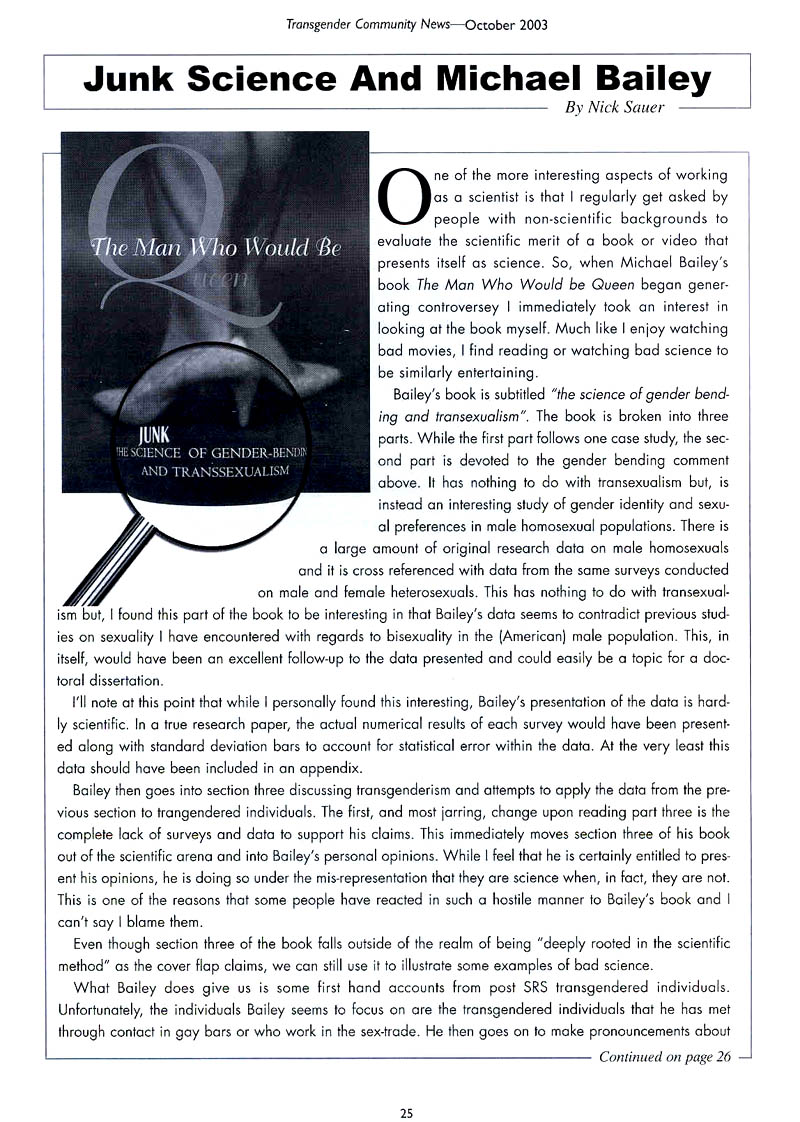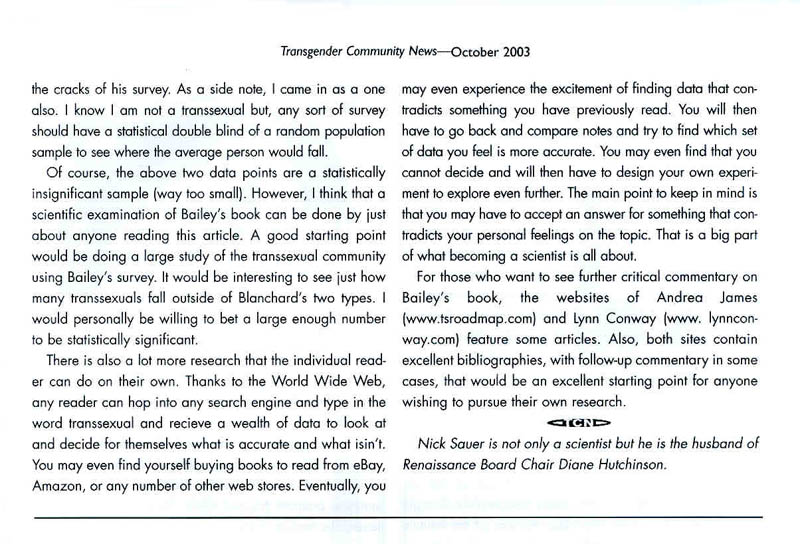- Transgender Community News
- Published
by The Renaissance Transgender Association
- October 2003
-
- Junk Science And Michael Bailey
- By Nick Sauer
-
-
- One of the more interesting aspects of working as a scientist
is that I regularly get asked by people with non-scientific backgrounds
to evaluate the scientific merit of a book or video that presents
itself as science. So, when Michael Bailey's book The Man
Who Would be Queen began generating controversey I immediately
took an interest in looking at the book myself. Much like I enjoy
watching bad movies, I find reading or watching bad science to
be similarly entertaining.
-
- Bailey's book is subtitled "the science of gender
bending and transexualism". The book is broken into
three parts. While the first part follows one case study, the
second part is devoted to the gender bending comment above.
It has nothing to do with transexualism but, is instead an interesting
study of gender identity and sexual preferences in male homosexual
populations. There is a large amount of original research data
on male homosexuals and it is cross referenced with data from
the same surveys conducted on male and female heterosexuals.
This has nothing to do with transexualism but, I found this
part of the book to be interesting in that Bailey's data seems
to contradict previous studies on sexuality I have encountered
with regards to bisexuality in the (American) male population.
This, in itself, would have been an excellent follow-up to the
data presented and could easily be a topic for a doctoral dissertation.
-
- I'll note at this point that while I personally found this
interesting, Bailey's presentation of the data is hardly scientific.
In a true research paper, the actual numerical results of each
survey would have been presented along with standard deviation
bars to account for statistical error within the data. At the
very least this data should have been included in an appendix.
-
- Bailey then goes into section three discussing transgenderism
and attempts to apply the data from the previous section to trangendered
individuals. The first, and most jarring, change upon reading
part three is the complete lack of surveys and data to support
his claims. This immediately moves section three of his book
out of the scientific arena and into Bailey's personal opinions.
While I feel that he is certainly entitled to present his opinions,
he is doing so under the mis-representation that they are science
when, in fact, they are not. This is one of the reasons that
some people have reacted in such a hostile manor to Bailey's
book and I can't say I blame them.
-
- Even though section three of the book falls outside of the
realm of being "deeply rooted in the scientific method"
as the cover flap claims, we can still use it to illustrate some
examples of bad science.
-
- What Bailey does give us is some first hand accounts from
post SRS transgendered individuals. Unfortunately, the individuals
Bailey seems to focus on are the transgendered individuals that
he has met through contact in gay bars or who work in the sex-trade.
He then goes on to make pronouncements about all transexuals
based upon observations of these individuals. This is what statisticians
refer to as biased data. In order for data of a group to be
valid there has to be a lot of individuals in the study group
and the group has to be statistically random. Since we don't
know how many individuals where in Bailey's study group (he never
gives a number) we can not address whether his sample size is
large enough to be statistically significant. However, it is
rather obvious that his group is not very random. Now, to cut
Bailey a little slack it would be all but impossible to do a
truely random survey of the transgendered community due to the
obvious fact that most members prefer to seek anonymity. The
problem is that Bailey didn't seem to make any kind of serious
effort to look for transgendered individuals outside of his regular
contacts. As a basis of compairison, this would be like me conducting
a study of theAfrican-American population by visiting the slums
of Newark, New Jersey and then making pronouncements about all
African-Americans based upon these contacts alone. Such a prejudiced
view of this population would be attacked, and rightfully so,
as it would be easily viewed as border-line hate literature.
This is another reason why many people have taken offense to
Bailey's book and one that I am completely in agreement on.
-
- Another thing that I find distasteful on a more personal
level about this is that Bailey presents this under the guise
of science -- when it isn't. As a scientist I tend to be more
sensitive to how we portray ourselves to the public than most
of my colleagues. The problem is that the very powerful images
created by literature such as 20,000 Leagues Under the Sea and
Frankenstein have done little to give people a positive outlook
on scientists.My concern is that Bailey's book is going to contribute
to the public's already jaded view of scientists and that really
irritates me on a professional level.
-
- Another thing that Bailey does is use the model of transexuals
developed by Ray Blanchard that basically categorizes transexuals
into two groups labelled homosexual and autogynephilic. About
the most diplomatic thing that can be said about this categorization
scheme is that it is controversial. It is certainly not a universally
accepted concept. However, this doesn't stop Bailey from using
it as the only accepted model and then forcing every subject
in his book into one of these two categories. What is interesting
is that Bailey is so locked into this theory that he can not
see outside of it to realize that maybe it isn't as all inclusive
as he believes. He actually mentions in the beginning of his
further reading section for chapters 8 and 9 that the popular
literature completely ignores this two category model. One thing
that was pounded into my head by my work associates was to keep
an open mind with respect to theories and their application to
real world results. The fact that a large percentage of the
transgender literature ignores Blanchard's theories should have
caused Bailey to reconsider its applicability. At the very least
I feel he should have pointed out that Blanchard's theories are
potentially dated and not universally accepted by the psychological
community.
-
- A side point that goes along with this is that Bailey doesn't
footnote his book at all. In the above case it is less of an
issue in that he actually gives author credit so, an individual
can go and find the source material for themselves. However,
throughout the book, Bailey will quote numbers without stating
where he got them from. As an example, on page 207, he discusses
how 80% of male-to-female SRS subjects are considered to have
successfully transitioned and even mentions that the methods
of measuring success vary from study to study without ever mentioning
at least one source for these studies. Ironically, the book
I interrupted to read Bailey's is the excellent book by Stephen
Ambrose titled Citizen Soldiers. This is an historical book
as opposed to a scientific one and it has tons of footnotes provided
throughout each chapter.
-
- Another artifact created by Bailey from the homosexual/autogynephilic
typing concept is a cute little survey to differentiate transsexuals
into which category they belong. Bailey then admits that this
survey is completely untested! My question to him is what was
the point of publishing it then? This is about as far removed
from science as one can get. Regardless of this, I had my wife
take the survey. I would also note at this point that a number
of the questions where ambiguously worded. The number she came
up with was one. This falls outside of the scale Bailey gives
so, what does this mean? Does it mean she isn't a transexual?
As a post SRS transexual I would find this hard to believe but,
Bailey doesn't address what happens to individuals who fall through
the cracks of his survey. As a side note, I came in as a one
also. I know I am not a transexual but, any sort of survey should
have a statistical double blind of a random population sample
to see where the average person would fall.
-
- Of course, the above two data points are a statistically
insignificant sample (way too small). However, I think that
a scientific examination of Bailey's book can be done by just
about anyone reading this article. A good starting point would
be doing a large study of the transexual community using Bailey's
survey. It would be interesting to see just how many transexuals
fall outside of Blanchard's two types. I would personally be
willing to bet a large enough number to be statistically significant.
-
- There is also a lot more research that the individual reader
can do on their own. Thanks to the world wide web, any reader
can hop into any search engine and type in the word transsexual
and recieve a wealth of data to look at and decide for themselves
what is accurate and what isin't. You may even find yourself
buying books to read from eBay, Amazon, or any number of other
web stores. Eventually, you may even experience the excitement
of finding data that contradicts something you have previously
read. You will then have to go back and compare notes and try
to find which set of data you feel is more accurate. You may
even find that you can not decide and will then have to design
your own experiment to explore even further. The main point
to keep in mind is that you may have to accept an answer for
something that contradicts your personal feelings on the topic.
That is a big part of what becoming a scientist is all about.
-
- For those who want to see further critical commentary on
Bailey's book, the websites of Andrea James (www.tsroadmap.com)
and Lynn Conway (www.lynnconway.com)
feature some articles. Also, both sites contain excellent bibliographies,
with follow-up commentary in some cases, that would be an excellent
starting point for anyone wishing to pursue their own research
- .
- -TCN-
-
- Nick Sauer is not only a scientist but he is the husband
of Renaissance Board Chair Diane
Hutchinson
|





